Ryan Hall's Blog, page 323
November 12, 2015
ASICS Introduces Luxurious (and Limited) MetaRun Shoe
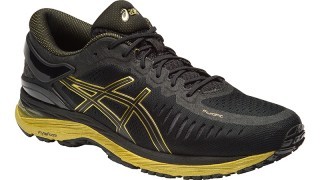
NEW YORK—Automakers are well known for their “concept cars,” models that showcase the most innovative technologies in a company’s arsenal but will never see a showroom floor.
ASICS debuted its own version of a “concept shoe” at a media event in Manhattan on Tuesday, and while the MetaRun will make it onto the feet of the running public (albeit in limited quantities and distribution), like a concept car, many of the technological features figure to trickle down to the company’s stable of shoes in future iterations.
The MetaRun will be available in running specialty stores on Nov. 28 and the limited quantity is expected to be gone by the end of the year. With a list price of $250, there probably isn’t the demand to crank out hundreds of thousands of pairs, but the shoe is an impressive example of what ASICS can do when its developers are unleashed with no constraints.
Three years in the making, the MetaRun combines five technologies that will likely influence many of ASICS’ other models in years to come. FlyteFoam is a newly patented midsole material, about 55 percent lighter than industry standard foam used in other shoes. But beyond being lighter in weight, it is also more resilient to increase cushioning. Built-in organic fibers embedded in the foam instantly return the midsole to its original shape after each stride to provide the same cushioning from start to finish and increase the midsole’s durability.
AdaptTruss is also newly patented and is a carbon reinforced two-piece adaptive stability system beneath the arch. Like a self-tuning automobile suspension that adjusts stiffness in response to terrain, AdaptTruss will flex safely under normal footplant but become rigid if the arch of the foot rolls too much. It not only adapts to the support needs of individual runners, but also provides progressive adaptive support and smoother transition, reducing local pressure as the runner’s arch drops during a long distance run due to fatigue and change in biomechanics.
RELATED: 2016 Running Shoe and Apparel Trends
Sloped DUOMAX is a dual density midsole that is precisely shaped and positioned to adjust to dynamic motion, and in conjunction with AdaptTruss provides adaptive stability and pressure reduction for smoother transition through the stride.
X-GEL is a hybrid high-tech gel, a refinement of the cushioning system that has been ASICS’ signature for almost two decades. Strategic design and placement of the X-GEL pads allows their size to be significantly reduced, resulting in a commensurate savings in weight.
An optimized upper design and construction also reduces weight and improves fit. Made of a single-layer engineered jacquard mesh to minimize rubbing between the foot and the upper, it results in a sock-like fit. A combination of closed and open weave patterns also optimizes flexibility and breathability. Combined with a newly designed exoskeleton external heel counter, known as MetaClutch, it wraps the lateral and medial side of the ankle bone, and in conjunction with built-in memory foam lining provides a personalized and secure heel fit.
Compared to ASICS’ flagship shoe, the GEL-Kayano 21, the MetaRun is 20 grams lighter, at 310g total shoe weight (10.9 ounces), exhibits 30 percent lower foam density in the FlyteFoam midsole, has increased stability (28 percent more in the rearfoot, 15 percent midfoot), has improved static (44 precent lateral and 26 percent medial) and dynamic fit (12 and 15 percent respectively), and an 18 percent increase in rearfoot cushioning.
Taking a cue from Henry Ford and his Model T, ASICS is offering the MetaRun in any color you want, as long as it’s black. The subdued gold trim gives it a look of understated elegance, like a running shoe version of a Range Rover or Toureag. The limited distribution means you may not see the MetaRun on the feet of many runners at your local race or workout spot, but if it’s true to its concept car inspiration, expect to find some of these groundbreaking technologies in other ASICS models in the not-too-distant future.
The post ASICS Introduces Luxurious (and Limited) MetaRun Shoe appeared first on Competitor.com.
November 11, 2015
Then and Now: Runner Loses 100 Pounds Before Rock ‘n’ Roll Las Vegas
Before (left) and after (right) shots of Eloy Gonzalez after losing a total of 100 pounds in four years due to running and a healthy diet.
Eloy Gonzalez was living the fat life: Selling condos in Puerto Peñasco, Mexico, traveling the world, and playing Texas Hold ’Em in Monte Carlo, France, Netherlands and Las Vegas.
The problem was, he was also literally fat, at 5 feet 8 inches and 295 pounds. In December 2011, Gonzalez tried squeezing into a suit before visiting his mother but no matter how hard he sucked in his gut, buttons weren’t buttoning, zippers weren’t zipping.
“I became morbidly obese,” says Gonzalez, now 43 years old.
Contrast that to the Eloy Gonzalez who will be lining up to run this Sunday night’s GEICO Rock ‘n’ Las Vegas Half Marathon. Now he weighs 185 pounds. “At least one-third of me is gone,” marvels Gonzalez, who now lives in Tucson, Ariz.
RELATED: 14 Things To Know About Rock ‘n’ Roll Las Vegas
Pizza, soft drinks and fast food, along with the pack-a-day cigarette habit, have been replaced by vegetables, water and protein shakes. The Las Vegas race will be Gonzalez’s 10th Rock ‘n’ Roll Marathon Series event of the year, and the guy loves Sin City more than any gambler, showgirl or entertainer.
“I am going to run Vegas every year for the rest of my life,” says Gonzalez, whose first half marathon was Rock ‘n’ Roll Las Vegas in 2012.
But before reaching the high-on-life space he fills now, Gonzalez sank to a canyon-deep low. That was back when he couldn’t fit into a suit. He had given up smoking the year before, and in place of cigarettes, he stuffed street tacos, quesadillas, cheeseburgers, French fries, Doritos and ice cream in his mouth. He kicked the tobacco habit, but plastered 50 pounds across his already large frame.
“My brothers had a hard time recognizing me from the year before,” he says. “I wanted to play with my niece and nephews, but I couldn’t. I felt bad.”
On Dec. 28, 2011, Gonzalez visited the doctor who told him he was pre-diabetic. “My life is close to over,” he remembers telling himself. “I am fat. I am so sick. I am not going to be alive in five years if I don’t make changes. I am not going to change my body; I am going to change my mind.”
So, Gonzalez cut back on his work schedule. He learned how to cook healthy food. He ate four to five small meals a day. He started walking. He walked up to 30 minutes, then added a minute of jogging, gradually tacking on more running.
In May 2012, having lost 40 pounds, Gonzalez was playing poker with friends and one of them suggested he run a half marathon.
“C’mon, I am not an athlete,” Gonzalez had replied. “Don’t make fun of me. I’m just losing weight.”
The friend sent Gonzalez a list of half marathons. When Gonzalez spotted the Rock ‘n’ Roll Las Vegas Half Marathon, his eyes rolled in excitement like sevens on a slot machine. Gonzalez showed up to The Strip in 2012, down 70 pounds to 225. He knocked off his first half marathon, finishing in 2 hours, 56 minutes, 38 seconds.
Even now, three years later, having dropped another 40 pounds—he’d like to lose 20 more—Gonzalez is not consumed by the clock. He finished his second marathon earlier this year at Rock ‘n’ Roll Arizona, crossing the line in 6:51.
“I don’t care who wins. I run for my life. Let Meb [Keflezighi] win,” Gonzalez says. “I don’t care about the time. I still [run] with no watch. My attitude is, ‘No fun, no run.’”
Gonzalez adds that he’s even a better poker player now because his body is healthier and his mind sharper.
“I used to fight myself,” he says. “I was so tired. My blood wasn’t right. My eyes were tired. Players took advantage of me. Now, I run in the morning, eat salads and I’m picking up all those pots. In running, you have to be patient, you have to be smart, you have to put everything together, you have to rest. It’s the same in poker. You have to be disciplined.”
In the midst of writing a book, telling his story, Gonzalez wants to provide health tips and a how-to narrative so that people can jump-start their lives.
“It doesn’t matter if you’re 500 pounds or 60 years old or a boy or girl or live in Mexico or Africa,” Gonzalez says. “You can do this. I know how to help somebody who doesn’t know how to start. They see pictures of me before and now, and they know I am not lying.”
RELATED: Craig Lutz Gambles for Greatness at Rock ‘n’ Roll Las Vegas Half Marathon
The post Then and Now: Runner Loses 100 Pounds Before Rock ‘n’ Roll Las Vegas appeared first on Competitor.com.
9 Great Waterproof Shoes For Fall/Winter Running
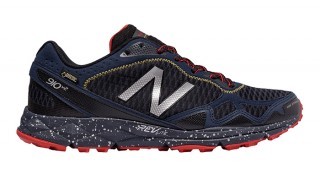
Depending on where you live, running from November to April might mean slogging through cold, wet, slushy, snowy or muddy conditions. Do you need a pair of waterproof running shoes? Ultimately, the answer comes down to the conditions you regularly run in and your personal preference. Waterproofing technology from Gore-Tex, eVent and Polartec has improved considerably in recent years, allowing waterproof shoes to be more flexible and breathable than those sold five to 10 years ago. Consider, too, that many water-resistant shoes (which offer more breathability but less weather protection than waterproof models) might suffice.
The Pros
• Feet generally stay warm and dry in wintry conditions and allow for uninhibited running in inclement weather conditions. Plus, there’s less chance of getting cold feet or even frostbite, and, of course, they eliminate some of the excuses for not running in bad weather
The Cons
• Waterproof running shoes are typically not as flexible and are a bit heavier as compared to traditional models without waterproofing, and they often cost $15–$30 more than non-waterproof models. Feet are still vulnerable to getting wet from moisture that enters at the sock and wearing waterproof shoes in in mild or warm weather can make feet feel hot.
Here are nine great waterproof running shoes for fall/winter running in whatever kind of bad weather you encounter.
Photo Gallery
1 of {count}
Back to Start
View Larger Image

Under Armour Fat Tire GTX, $199
This is the shoe for you if ... you want maximum protection from the elements from a shoe that is in its element in wintry conditions (and especially deep snow).
Fit-feel-ride: The Fat Tire lives up to its name and design of a shoe that was meant to mimic a mountain bike tire rolling over terrain. This shoe serves up a super cushy and lively ride thanks to two layers
of soft foam that give it a high-off-the-ground feeling. The GTX high-top version of this shoe has a waterproof upper and a new Michelin rubber compound,
plus a slightly rockered profile from heel to toe and side to side. (There is also a water-resistant low-top version of the Fat Tire.) Our wear-testers found it amazing on wet, muddy terrain and exceptional on snowy, slushy trails. This shoe is heavier than most trail running shoes—it has a lot of girth—but it feels less so in sloppy, wet terrain or in snow. It’s not an ideal
choice for hard-packed trails and dirt roads, where it feels a bit
unstable. But we loved it running through marshy swamp trails and deep snow on the roads.
Weights: 18.0 oz. (men's size 9.0) (Note: This shoe is available only in unisex sizing.)
Heel-Toe Offset: 10mm; 27mm (heel), 17mm (forefoot)
View Larger Image

Altra Lone Peak NeoShell, $150
The shoe is for you if … you’re an Altra and/or zero-drop devotee, and want to a winter shoe with superior weather protection.
Fit-feel-ride: This shoe is built off Altra’s popular Lone Peak 2.5, a cushy shoe with a zero-drop profile that seems to put a little spring in your step. The Neoshell version has the same roomy toe box fit of the regular 2.5, allowing toes to splay naturally, especially on long descents. This shoe has durable, waterproof exterior that kept testers’ feet dry even when dunking in a shallow creek. It earned the "Best Weather Protection" award in Competitor's October 2015 trail running shoe review. It differs from other weather-protecting shoes in this roundup by putting the waterproofing in the exterior of the shoe, eschewing a heavy, wet upper and abating an overly hot foot. The underfoot traction grips a range of surfaces with aplomb. The bottom line is that this shoe will keep you charging trails in snow and cold. One drawback: If the fit isn’t perfect (they run a tad large on foot), there can be some awkward buckling at the toe crease.
Weights: 11.9 oz. (men’s size 9.0); 10.4 oz. (women’s size 7.0);
Heel-Toe Offset: 0mm drop; 25 mm (heel), 25mm (forefoot)
View Larger Image

Montrail Bajada II Outdry, $135
This shoe is for you if … you tackle gnarly trail in foul weather and demand maximum protection for your feet.
Fit-feel-ride: This shoe is a burly workhorse that manages to run lighter than it weighs. Its Gryptonite outsole grabs the trail, wet or dry, but it’s the upper that made us feel like we could charge anything. The screened rubber overlays kept rocks and roots from poking through the sides of the shoes; we felt like our feet were enclosed in a guarded little case. The waterproof Outdry liner of the upper only increases the protection; this shoe blocks rain and snow and helps keep feet warm. Bottom line: It’s a rugged, durable shoe that still flexes and doesn’t weigh you down. The Bajada II Outdry isn’t as nimble- or agile-feeling as some other trail runners, and it runs a little stiff, but for technical trails (especially in foul weather), it’s a huge hit. The only drawback is that this shoe feels a little clunky on smooth, non-technical trails.
Weights: 13.1 oz. (men’s size 9.0); 10.9 oz. (women’s size 7.0);
Heel-Toe Offset: 10mm offset; 20mm (heel), 10mm (forefoot)
View Larger Image

The North Face Ultra MT GTX , $150
This shoe is for you if … you don’t want to hold back on mountain runs.
Fit-feel-ride: With its Vibram “Megagrip” outsole, its durable ripstop mesh upper that wraps around the midsole and the semi-firm ride of the cushioning, The North Face Ultra MT is a hard-charging mountain shoe. It actually feels strong and solid on the foot, and holds up to sharp, rocky terrain. The traction of this shoe is what stands out the most. It gripped everything from slick to dry rock, soggy ground, dusty trails and more. Some testers craved more cushioning around the heel collar near the tongue, and others noted how the narrow fit of these won’t work for everyone. The thin yet nicely padded tongue lays comfortably on the foot, and the “FlashDry” lining wicks sweat and moisture in a jiffy. For how durable and burly this shoe is, it’s still fairly lightweight. The non-stretchy laces (which need double knotting) could be felt by some across the top of the foot.
Weights: 9.7 oz. (men’s size 9.0); 8.2 oz. (women’s size 7.0);
Heel-Toe Offset: 8mm; 23mm (heel), 15mm (forefoot)
View Larger Image

Brooks Adrenaline ASR 12 GTX, $150
This shoe is for you if … you need stability in a versatile shoe that’s treated for winter weather.
Fit-feel-ride: This foul-weather-ready shoe has a road-shoe feel. Its midfoot stability, ample cushioning and smooth ride make it a pleasure to run in on smooth dirt and less-than-technical terrain. Updated from the previous version of this popular shoe is a segmented crash pad (all that toothy red and black rubber near the back of the shoe), which allows a more fluid ride than in past iterations of the Adrenaline ASR. The outsole has also been updated to handle sloppy trails better. Testers didn’t find it the most “dynamic” or “agile” shoe on technical trails, likely due to its road-shoe profile and plentiful cushioning. The Gore-Tex weather-proofing adds to the versatility of this winter shoe—wear it on sloppy road runs as well as off-road. This shoe is cut low around the ankle collar, which some testers found enhanced comfort. The stability for pronators will be overkill for some (but a plus to those who need it.)
Weights: 11.8 oz. (men’s size 9.0); 9.9 oz. (women’s size 7.0);
Heel-Toe Offset: 12mm drop; 32mm (heel), 20mm (forefoot)
View Larger Image

Saucony Ride 8 GTX, $140
This shoe is for you if … you need weather protection in a smooth-riding cruiser for the open roads.
Fit-feel-ride: The Ride has consistently been upgraded through the years and it remains a durable, cushioned everyday trainer for a wide range of runners. The latest incarnation has a much-improved upper, one that is wrapped with seamless flex film overlays that help create a snugged-down fit while also accommodating for a variety of foot shapes. The winterized version of the Ride 8 has a lightweight interior bootie made from Gore Flex, the latest waterproof technology from Gore-Tex. As a result, it's not as stiff or heavy as some waterproof shoes from the past, but instead it's a flexible and lightweight uptake from the neutral-oriented Ride. It's soft and cushy with just a tad bit of responsive energy to put a spring in your step, making it a good choice to do some of your normal training runs in on sloppy, slushy roads.
Weights: 9.8 oz. (men’s size 9.0); 8.5 oz. (women’s size 7.0);
Heel-Toe Offset: 8mm drop; 27mm (heel), 19mm (forefoot)
View Larger Image
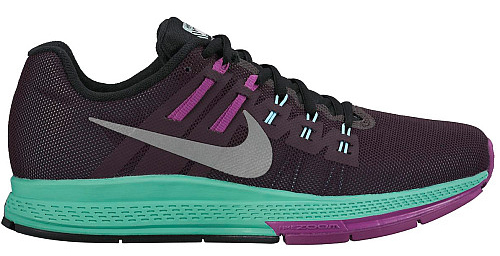
Nike Air Zoom Structure 19 Flash, $135
This shoe is for you if ... You're looking for a very supportive road running shoe that offers a good amount of weather protecton.
Fit, Feel, Ride: With a triple-layer upper, the Structure 19 boasts water repellency, thermal conservation and, in a mod, Nike sort of way, iridescent reflectivity. The reflectivity is passive in normal light conditions, but luminous like when caught in a glare. The sock-like inner layer holds nicely while the second reflective film of the second layer shields moisture, and the outer layer is a rugged yet breathable mesh. The midsole is also three layers: a denser foam from heel to medial mid-foot; a dynamic foam support wedge incorporated into the dual-density meat of the midsole unit; and a forefoot Zoom Air unit to appeal to mid- and forefoot strikers. The waffle and segmented crash rail along the outsole serve up durability, traction and easy heel-to-toe transition.
Weights: 10.5 oz. (men’s size 9.0), 9.2 oz. (women’s size 7.0);
Heel-Toe Offset: 10mm; (28mm heel, 18mm forefoot)
View Larger Image

ASICS GEL-Cumulus 17 GTX, $140
This is the shoe for you if … you're looking for a comfortable road-shoe fit and sensation while having reliable waterproof protection.
Fit, Feel, Ride: In addition to its new upper (which includes an interior support saddle), the GEL-Cumulus was updated with ASICS’ new midsole and fore- and rear-foot silicon-based GEL units. This buffers a somewhat rigid ride that holds up admirably to cold pavement. The seamless upper and Gore-Tex interior lining is a burly waterproof barrier against frost and slush, making this version of the Cumulus suited for winter running. The midsole package also provides mild motion control , and the upper features a medium volume fit: not too tight, not too loose. All of that cushioning and upper protection comes at the cost of more weight, but naming this shoe after a cloud isn’t a misnomer—it evenly surrounds the foot and, when in motion, doesn’t feel hefty.
Weights: 12.5 oz. (men’s size 9.0), 10.0 oz. (women’s size 7.0);
Heel-Toe Offset: 10mm; (30mm heel, 20mm forefoot)
View Larger Image

New Balance 910v2, $135
This is the shoe for you if … you want a trail cruiser designed for moderate to mild trails with weather protection.
Fit, Feel, Ride: This versatile trail runner becomes even more versatile with a waterproof inner bootie fit system. Testers liked the combination of cushion, comfort and flexibility in this shoe. Although it’s a neutral model and more cushioned than many trail shoes, the moderate heel-toe drop offers a hint of agility and stability, while the firm heel cup adds structure and a more secure sensation on all types of trails. Cushioned, easy-riding comfort with underfoot rock protection make this shoe runnable for long trail hauls, but equally possible for road jaunts. Narrow-footed testers felt the wider fit lacked nimbleness on the trail, but those who needed the volume were thrilled about the fit and ride.
Weights: 10.3 oz. (men’s size 9.0); 8.2 oz. (women’s size 9.0);
Heel-Toe Offset: 7mm drop; 26mm (heel), 19mm (forefoot)
Related Galleries

This Summer’s Best Shoes: Best of Competitor Wear-Test Awards

Sneak Peek: 17 New Summer/Fall 2015 Running Shoes

Sneak Peek: 25 New Running Shoes Coming Out In Spring/Summer 2015
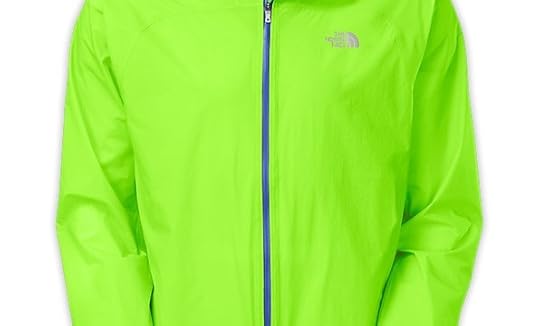
Essential Gear For Multi-Hour Mountain Running

More Galleries
The post 9 Great Waterproof Shoes For Fall/Winter Running appeared first on Competitor.com.
Shoe Of The Week: New Balance Fresh Foam Zante Sweatshirt
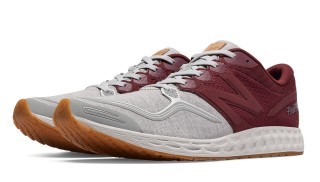
This running shoe passes the "looks good with jeans" test, but it can still run with a quick-cadence gait on your next tempo workout.
Normally we feature performance-oriented shoes in our Shoe of the Week post, but this week we take a look at a shoe that passes the “looks good with jeans” test and also runs pretty darn well too. Although it’s a special make-up of New Balance’s award-winning Fresh Foam Zante shoe and can still run fast for 800m to the half marathon, this version definitely has an urban/hipster/lifestyle look about it. New Balance calls it “a mash up of performance running technology and street-inspired materials made for everyday wear.” It’s ever-so-slightly heavier than the original performance model that came out last spring (partially because it has some premium lifestyle upgrades, including leather accents on the tongue and heel and a gum rubber outsole) but it’s still light enough to have a footloose and fancy-free demeanor about it. We love this shoe, which is why we included it in the men’s lifestyle section of our 2015 Holiday Gear Guide. New Balance is on to something here—namely that running shoes are comfortable enough to wear all the time but we don’t want to wear the shoes we run all the time because they’re typically dirty, worn and smelly—so it created a version you can wear with casual clothes. (It’s also making a leather version of the Zante!) Do you have other running shoes you like wearing with casual clothes? We definitely do.
RELATED: 2015 Holiday Gear Guide—Men’s Lifestyle Gear
Like the original performance-oriented Zante, this shoe has a comfortably snug, low-volume interior complemented by a foot-wrapping bootie that provides incredible foot-to-ground proprioception and agility, making up-tempo running, mall walking and bar hopping a breeze. The comfy interior—enhanced by a premium footbed—and lightweight materials give this shoe an energetic demeanor from the moment you lace it up. The combination of the resilient Fresh Foam midsole and considerable toe-spring design encourage a quick cadence, which can put a spring in your step no matter what you’re doing.
This is the shoe for you if: … You’re looking for a lightweight, versatile casual shoe for a wide range of training or everyday activities.
Price: $120
Approximate Weights: 8.0 oz. (men’s), 6.7 oz. (women’s)
Offset: 6mm; 16mm (heel), 10mm (forefoot)
RELATED: Shoe Of The Week—Hoka One One Clifton 2
The post Shoe Of The Week: New Balance Fresh Foam Zante Sweatshirt appeared first on Competitor.com.
November 10, 2015
Police Officer and Injured Rock ‘n’ Roll Savannah Finisher Go Viral
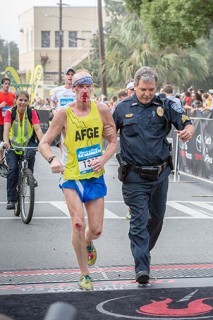
Photo: Casey Jones Photography
Just 200 yards from the finish line of the Rock ‘n’ Roll Savannah Half Marathon on Saturday, 49-year-old Robert McCoy tripped and fell onto the hard asphalt, face-first. He was bleeding heavily from his nose and around his eye and had cuts on both his knees.
Emergency personnel immediately rushed to him, including Savannah-Chatham Metropolitan Police Department Sgt. John Cain. McCoy was clearly banged up, but as EMTs attended to him, he insisted that he needed to finish the race. So he got up, and with the assistance of Cain, made his way toward the finish line.
The runner and the officer crossed together, in an image captured by Casey Jones Photography (above) that has gone viral. McCoy’s time was 1:41:46.
“I went over to help render aid and he kept saying, ‘I’ve got to finish the race,'” Cain said afterward. “I asked him if he wanted me to help him and he said yes. I put my arm around his shoulder and back. I could feel in my heart that he needed to finish, there was a purpose for him doing so and he wanted to accomplish the goal. I am just glad I was in a position to help him do that. He in an inspiration to me, he is the hero in this story.”
RELATED: Photos: 2015 Rock ‘n’ Roll Savannah
In no time, the story spread rapidly. It’s been featured on Buzzfeed, TIME, NBC’s Today, ESPN’s SportsCenter and dozens of other outlets.
Here’s a video of the inspirational finish, taken by Josh Jasso:
The post Police Officer and Injured Rock ‘n’ Roll Savannah Finisher Go Viral appeared first on Competitor.com.
Workout Of The Week: Billat’s 30-30

Photo: www.shutterstock.com
The best runners possess two key characteristics: a high VO2 max (i.e. a high capacity to consume oxygen during running) and great energy economy (i.e. the ability to minimize energy use during running). One of the best predictors of running performance is a variable that puts VO2 max and economy together: namely, velocity at VO2 max — or vVO2 max — which is the slowest sustained running pace at which a runner reaches maximum oxygen consumption (or 100 percent VO2 max) in a standard “graded exercise test” performed on a treadmill. For example, suppose that during testing it is discovered that your VO2 max is 55 liters per minute per kg of bodyweight. If this rate of oxygen consumption is first achieved at a running velocity of 10 mph and shows no increase at higher running speeds, then your vVO2 max is 10 mph.
An improvement in either your VO2 max or your running economy will increase your vVO2 max (as well as the duration you can sustain this pace), and this in turn will improve your running performance in races more than any other factor. So what’s the best way to increase your vVO2 max? Actually, the best way to do it is simply to run a lot. But supposing you’re already doing this, there is one specific type of workout that boosts vVO2 max better than any other, and chances are you’re not doing it and you’ve never even heard of it.
The name of the workout is Billat’s 30-30, after its creator, Veronique Billat, an exercise physiologist at the University of Ille in France. Several years ago, Billat set a goal of trying to create workout formats that would allow runners to spend the greatest total amount of time at VO2 max and would therefore presumably produce the most powerful boosting effect on VO2 max and economy.
Billat deduced that runners seeking to maximize workout time spent at VO2 max should run at vVO2 max and no faster because they would fatigue more quickly at faster speeds. Remember, vVO2 max represents the slowest running pace at which VO2 max is reached. Her next move was a stroke of genius. Billat knew that a runner’s rate of oxygen consumption remains at or near 100 percent VO2 max for as long as 15-20 seconds after he or she stops running at vVO2 max, or slows down from this pace. Billat realized that a well-designed workout could exploit this lag phenomenon to allow runners to further increase time spent at VO2 max.
RELATED: Interval Runs Are Fun — And They Work
The best way to do this would be to alternate short intervals run at vVO2 max with short “floats” (jogging recoveries) at perhaps half of vVO2 max. Keeping the hard intervals short would delay fatigue by preventing depolarization of the muscles from getting out of hand. Keeping the floats short would prevent oxygen consumption from falling very far before hard work resumed.
The workout format she settled on was highly unorthodox, consisting of 30-second bursts at vVO2 max separated by 30-second floats and repeated to failure (that is, until vVO2 max can no longer be sustained for 30 seconds). In testing this format, Billat found that some runners were able to amass more than 18 total minutes at VO2 max, almost 1/3 of it occurring during their jogging recoveries. A group of moderately fit runners increased their VO2 max by 10 percent (that’s huge) in just 8-10 weeks when they added twice weekly 30-30 sessions to their training.
The only question is, how do you determine your vVO2 max? The only sure way is to perform a graded exercise test in a laboratory environment. But you can get a close approximation simply by running a 6-minute time trial on a track. Divide the total distance you run in 6 minutes by 12 to get the distance covered per 30 seconds. Suppose you run 1,720 meters in your 6-minute time trial. One 12th of this distance is 143 meters. This is roughly how far you should run your hard 30-second intervals in your 30-30 workouts. Here are some other guidelines:
RELATED: 3 Track Workouts For Beginners
— Warm up with 10 minutes of easy jogging
— Set the countdown timer on your watch for 30 seconds and reset it immediately at the beginning and end of each interval
— Run 30 seconds at your vVO2 max (control your pace by trying to cover exactly 1/12th of the distance you covered in your 6-minute time trial)
— Jog 30 seconds at roughly half of vVO2 max
— Repeat this process until you can no longer cover the designated distance at vVO2 max (16-24 intervals are the norm)
— Cool down with 10 minutes of easy jogging
— Do this workout once a week for 4-6 weeks beginning right after you’ve completed your winter/spring base building. (Expect to see the number of intervals you’re able to complete gradually increase from session to session; expect to see your pace increase gradually as well)
— After 4-6 weeks, switch to a 60-60 format for 4-6 weeks
— After another 4-6 weeks, switch to a format of 5 x 3:00 at vVO2 max with 3:00 jogging recoveries for 4-6 weeks
The post Workout Of The Week: Billat’s 30-30 appeared first on Competitor.com.
Craig Lutz Gambles for Greatness at Rock ‘n’ Roll Las Vegas Half Marathon
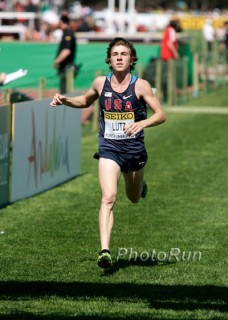
Photo: Photorun.net
Most newly minted professional runners take their time easing into longer-distance races, but not Craig Lutz. The 23-year-old, former four-time All-American at the University of Texas has done away with convention by toeing the line at this Sunday’s GEICO Rock ‘n’ Roll Las Vegas Half Marathon—his debut at the 13.1-mile distance.
Lutz, who set the Arizona state record for the road 5K (13:51) this past summer, isn’t mincing words about what he wants to do at Sunday’s race.
“First and foremost I want to win,” he says. “The field for Vegas is pretty strong with a good group of 1:03 guys and winning would most likely mean that I would accomplish my other goals too, which are to approach and break 1:03, negative split the second 10K, and have fun!”
Lutz runs for Northern Arizona Elite and is sponsored by the HOKA ONE ONE shoe company. He admits his training going into Sunday’s 13.1-mile race has been “stronger than ever.” Specifically, Lutz says he’s been grinding out 100-mile weeks and that he’s weathered this intense taxing of his body. “I felt as though a half marathon during this training block was appropriate,” he says. “I just ran a 13:51 5K last week so I am not worried that I am losing my speed endurance before track season starts.”
RELATED: 14 Things You Didn’t Know About the Rock ‘n’ Roll Las Vegas Marathon Weekend
It takes guts to win a race with a deep field like the one he’ll experience in Vegas and Lutz thinks he’s up for the task. “I want to be dominant in everything that I do, no matter the starting line. This week it’s a half marathon, December it will be a 10K, and maybe I’ll get to race in a mile or two in the early parts of 2016,” he says.
With this kind of racing schedule, Lutz could focus his efforts on potentially qualifying for the 2016 U.S. Olympic marathon team with a Trials qualifier this weekend (he would need to run 1:05 or faster), but he says he’s going to stay focused instead on the 10,000 meters on the track.
All Olympic dreams aside, Lutz says the Rock ‘n’ Roll Las Vegas Half Marathon comes at the perfect time in his training. He had planned to run the U.S. 12K Championships this weekend, but didn’t earn a qualifying mark for it and so the half fills the void for him.
PHOTOS: Images From The 2014 Rock ‘n’ Roll Las Vegas Marathon Weekend
“I told my coach [Ben Rosario] that I felt like a half marathon was a race event that I wouldn’t have to change workouts in order to be ready for, that the strength I’m acquiring from our large base would be good enough,” he says.
Besides the tough competition he faces and the self-determination required to gear up for a long debut race, Lutz says that there’s also a “fun” element he’s preparing for on Sunday. After all, he will be joined by thousands of festive runners along the flashy strip at night.
“I am so excited for this race!” he exclaims. “Vegas is a city that enjoys excitement and plays to the story of dramatic episodes so being that this is my debut, I hope I can play into that depiction of excitement.”
The GEICO Rock ‘n’ Roll Las Vegas Marathon weekend kicks off on Thursday with a three-day health and fitness expo at the Las Vegas Convention Center. Saturday night runners will be lacing up their shoes to take part in the Brooks 5K Presented by SLS Las Vegas and then on Sunday, the action continues with the 10K, half, and full marathon that start in the late afternoon.
Before the half and full marathon, five-time Grammy-nominated legend Kid Rock will take the stage at the Toyota Rock ‘n’ Roll concert powered by iHeartRadio.
The post Craig Lutz Gambles for Greatness at Rock ‘n’ Roll Las Vegas Half Marathon appeared first on Competitor.com.
Team RWB Grows With Trail Running Camps for Veterans
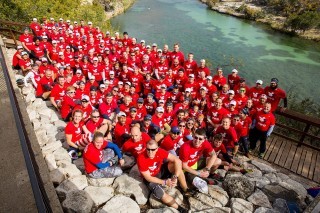
When veterans transition to civilian life, the loss of military community can be challenging to replicate. Team Red, White & Blue (Team RWB) was founded to help fill the void by connecting veterans and their families to their communities with sports. Participation happens at local chapters and clubs, with dozens throughout the U.S.
The intention is for Team RWB to be grassroots because each place and community is unique with specific needs. However, running is deeply entrenched in military training, making it a popular Team RWB activity no matter the location. So much so, that it’s becoming common for veterans and civilians alike to be seen wearing the group’s distinctive red, white and blue, eagle-logo RWB shirts and jerseys at running events, from local trail races to big city marathons.
Founded in 2010, the group has experienced exponential growth and now has more than 90,000 members in 182 communities around the world. It includes athletic camps, ambassador programs and leadership development programs in addition to sports meet ups.
Champion ultrarunner Liza Howard (women’s winner of the 2015 Leadville 100) heard about Team RWB on an Endurance Planet podcast, and thought trail running would be a fitting application for the program.
She contacted program founder Major Mike Irwin, and asked, “How can I help?”
Howard helped create the trail running camp, inviting professional and winning trail runners to help with the program. Elites like Max King, Meghan Arbogast, Sage Canaday, Katie DeSplinter, Dominic Grossman, Jason Schlarb, Sarah Lavender Smith, Nikki Kimball and many more have attended and shared their trail running expertise and enthusiasm. The popular national camp just wrapped its fourth year with 100 participants in Texas.
RELATED: Veteran Runs Ultras to Raise Money for Charity
“We have a 4:1 ratio of participants to mentors, and about half of the participants are veterans and the other half paying civilians who want to attend a stellar trail camp,” Howard says.” “We cover form, hill running, speed drills, race nutrition, first aid, trail etiquette and leave-no-trace ethics. Attendees have time to run with and talk to the best in the sport in a relaxed atmosphere.”
Ultrarunner Matt Hart has been involved since the first trail camp. Introduced to the program through Howard, he wanted to be involved because he saw how PTSD affected his dad after his two tours in Vietnam. “A lot of people are touched by veterans or have veterans in their lives,” Hart says. “Running can be a selfish pursuit, and any chance to give back, especially helping veterans, is a good opportunity.”
Hart, like Howard, says the camp is the type of program he would like to attend, even if he wasn’t a veteran or a volunteer.
“This is such a cool way to build community around trail running,” he says. “It’s a way to help the beginners and trail runners of all abilities learn about the sport.”
With running as a common thread, connections between veterans, civilians and mentors, even those with disparate backgrounds and beliefs, are seamless.
“Not only have we been able to make a difference in people’s lives by teaching them about trail running, we’ve shown them there is a community, a trail running community, and they can be part of it,” Howard says. “Civilians get to see that veterans are just like the rest of us. We are all so insulated in our communities and trail running can help break down those barriers—both emotional and physical.”
Participants range in ability from the fit and fast to those who only run when it’s required. Most though, according to Hart, are like “kids in a candy store and just stoked to run.” Those who may have started out thinking of running as a chore, come to enjoy it and the community by the end of camp. In addition to classes and group runs, veterans are given the opportunity to share their personal stories.
“The biggest thing to me was the fact that over a short four-day period, not only did I get some friends, I got a whole new family,” says Brandon Kuehn, a veteran who attended the 2015 camp. “These are men and women I know I can call on if I am in need.”
The community aspect is growing with camp participants and other Team RWB members reaching out to each other to do races and carpool to events.
“I was expecting just to run and learn some basic technique, but I learned so much more,” Kuehn says. “You don’t have to be an elite to race. Your race is your race.”
Program organizers are considering offering regional camps in the future to help runners connect with their local communities at a lesser cost.
To learn more about Team RWB’s trail running camp, visit their website.
The post Team RWB Grows With Trail Running Camps for Veterans appeared first on Competitor.com.
Olympic Champion Bob Schul’s Four Life Lessons for Runners
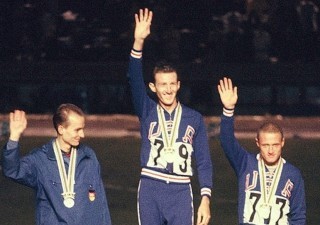
Bob Schul celebrates his 1964 Olympic victory. Photo: Wikimedia Commons
When most people think about the 1964 Olympic Games in Tokyo, they conjure up images of Billy Mills coming from behind in the final lap of the 10,000m to win gold. But another American, Bob Schul, took gold in the 5,000m, a feat that hasn’t been replicated in the last 51 years.
Schul was born in West Milton, Ohio and became a standout collegiate runner at Miami University. He joined the Air Force in 1960 and due to the influence of his commanding officer, world-class distance runner Max Truex, he trained under the legendary Hungarian coach, Mihály Iglói.
Schul’s 5,000m win in Tokyo was just as dramatic as Mills’ and wasn’t decided until the final 300 meters of the race. Schul found an extra gear and powered past France’s Michel Jazy on the muddy track to claim the Olympic title.
The now 78-year-old Schul is a wealth of knowledge and inspiration, and shares his four top life lessons for runners below.
Learn from knowledgeable people.
For Schul, this was Iglói. “When I first ran under [him] for two weeks, I knew that this man could bring my body to a state where I could be one of the best runners in the world,” he recalls. But Schul cautions that runners must be judicious about deciding whom they choose. “You must be careful when you believe you have found such a person, that they are what you are looking for,” he says.
Believe in yourself.
Schul points out that self-confidence plays a big role in performing at a high level. He says we need to believe in how we feel about the training program we have chosen to follow and the progression we make as we continue to ask more of our bodies. “If a particular training session becomes easier a month or two after you first did it, then you can surmise your body has progressed,” he says.
Don’t give up.
Schul struggled with a persistent knee injury throughout his running career. He also had asthma. Outside of running, Schul also had difficulties, declaring bankruptcy on a business venture in the early 70s. But through it all, he refused to make excuses or quit on himself. “I had to regroup and I reopened a shoe store because my credit was good,” he recalls. “I could have sat around and felt sorry for myself but that would have been worthless. Things will go wrong in most people’s lives and you must decide what you want to do and go about making things happen.”
Give back to those who seek your advice.
After he retired from running in 1966, Schul lived in California and began training runners without charging them for his services. Six years later, he moved back to Ohio and had runners approach him looking for help and his training group quickly grew to over 40 people. From that point, Schul’s coaching success blossomed as the Air Force sent him their 10 best runners for training. Schul helped turn these mediocre college athletes into some of the best runners in the country, including three sub-4 minute milers and a national steeplechase champion. “All 10 were willing to work and I must admit it was the most fun I have ever had,” Schul says. “You might think I only chose those who had run well or I thought had potential. That was not the case as I never turned anyone away.”
The post Olympic Champion Bob Schul’s Four Life Lessons for Runners appeared first on Competitor.com.
Calling All Runners: Obstacle Racing Fun Awaits
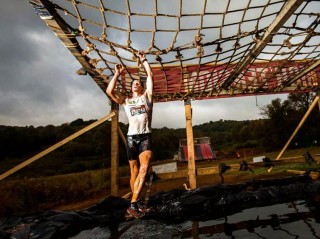
Max King maneuvers his way along the bottom of a cargo net on his way to winning the Warrior Dash World Championship on Oct. 10 in Pulaski, Tenn. Photo: Warrior Dash
Every time I rock up to the start of an obstacle race, I get the chills down my spine because I know how much fun I’m about to get myself into. It’s a truly palpable sensation and the only thing that remotely compares to it is how I feel on the starting line of a cross country race. Don’t get me wrong, I enjoy running on roads, trails and the track, but there’s nothing quite like the thrill of fast-paced racing on undulating terrain full of obstacles—no matter if they’re natural or manmade.
But I understand that some runners might feel anxious, overwhelmed or even terrified about entering an obstacle race. I showed up for my first one on a whim a couple of years ago and I felt utterly unprepared, intimidated beyond belief and … also very giddy that I was about to try out the ninja athletic skills I started honing as a kid on some bad-ass cargo nets, mud pits and vertical walls all designed to be very difficult to conquer.
I did OK and managed to get through most of the course without any epic fails—that is until I jumped up to grab the lip of the final 8-foot wall and just hung there, not knowing what to do next. I struggled to get up and over with terrible form—crunching my you-know-what in the process—fell off the other side and slogged across the finish line, totally worked but elated because it was so dang fun. I looked back at the course, imagined it in my mind without obstacles and saw one of the best cross country courses I’d ever run. I was hooked! The challenging course, the sometimes intense but supportive community around the race and the festival at the finish made it all a great event and a memorable experience. (It’s one of the reasons people with all sorts of athletic backgrounds are flocking to adventure racing.)
RELATED: Obstacle Course Racing Tips
One of the best parts about obstacle racing is that it brings together two athletic communities that—without these types of races that mix endurance with the need for power, agility and quickness—would be worlds apart. The distance-running crowd meets the uber-athletic fitness community! I don’t want to draw stereotypes, but from the outside, it’s a weird mix and, I admit, I was a bit apprehensive when I first got started. And who wouldn’t be intimidated when you’re about go to up against dozens of 6-foot, 205-pound dudes made of rock-solid muscle on the start line? (The women are equally buffed out and athletic!) No need to freak out, though. Trust me, your endurance training and innate determination as a distance runner will carry you through it, even if you don’t possess the raw power or dynamic agility.
There are different types of obstacle race events and they vary significantly, as each one focuses on a different skill set.While many of the obstacles are common among races, (walls, barbed wire crawls, cargo nets) each race has a set of unique obstacles they call their own. Some will play to your strengths, others will expose your weaknesses. But that’s the fun of it. No matter which race you choose, you’ll have to adapt and persevere to reach the finish line.
Here’s a little primer on the different races out there and what training you’ll need to get through it.
1) Getting Started
A great first obstacle race is the Warrior Dash—a more for-the-fun-of-it type of race that’s un-timed and more about the mud, camaraderie and the post-race party than competition. If you’re a runner, this type of race requires zero preparation, other than just having an open mind to what’s coming next and a willingness to get dirty. This type of race is generally shorter (5K to 8K) in distance, uses efficiency-based obstacles (that you have to crawl over, under or through) and requires very little upper body strength to reach the finish line.
2) Progressing Your Skills
As you graduate from the 5K mud runs, you might find yourself in a Spartan Sprint race or another local obstacle race. These tend to focus a bit more on competition but still have a family and/or party atmosphere. Along with your efficiency obstacles, the race will have a few more upper-body strength based obstacles as well. These might include sandbag carries, rope climbs, tire flips, etc., but will also be things that most runners can accomplish with your typical functional fitness routine that all runners should be doing anyway. Hint hint!
3) Going Longer
The third level of obstacle race starts to favor the true obstacle racing athlete. These are typically longer in distance, 10K to 18K, and incorporate more difficult obstacles such as upper body strength-based obstacles, monkey bar-type obstacles, and just more obstacles where specific obstacle training is going to help you. The Battlefrog series as well as a Super Spartan are good examples of this type of race. Working in the gym on pull ups, finger grip strength with carries and bar hangs, as well as leg power is going to get you through the obstacles more efficiently and faster. However, these are still great for a runner willing to put in a little gym effort. Sorry, CrossFit fans but no amount of CrossFit Endurance is going to prepare you to run an obstacle race like this. There’s still a lot of running in any of these events, so you need to have your aerobic engine tuned like a runner.
4) Upping Your Game
If you’ve been hitting the weights a bit, but still keep up on your running fitness—and maybe you’ve even run a few ultramarathons—it’s time to up your game with a longer harder, more masochistic obstacle race. And trust me, they are masochistic. A Spartan Beast (20K+) or the much longer Worlds Toughest Mudder (24 hours) will test even the best athletes. I would suggest equal parts mountain running training and CrossFit training for taking on one of these types of obstacle races. These races are the ultras of the obstacle racing world and will take you to your limit, and quite possibly break you physically and mentally in the process, but the rewards of accomplishing one can’t be matched with any of the shorter types of races.
RELATED: Obstacle Course Racing Goes Big Time
As you get into obstacle racing, you’ll find out that there is something for everyone and that runners tend to excel at the sport because of their aerobic conditioning. Start with an event that’s a little less intimidating and, if you find that you like it, move on to a new challenge. Or not, because a short one with some good obstacles can be just as much fun (if not more) than a longer, more challenging course that may have you begging to just lie down in the mud and go to sleep. No matter what you do, don’t neglect your running fitness.
* * *
Salomon Running athlete Max King has been competing in a variety of different obstacle races for the past two years. He recently won the Warrior Dash World Championship and had a ton of fun getting muddy in the process. He’s also won numerous USATF trail running national titles, as well as the 2011 World Mountain Running Championships and the 2014 IAU 100K World Championships. Follow him at @maxkingOR on Twitter and Max King on Facebook.
The post Calling All Runners: Obstacle Racing Fun Awaits appeared first on Competitor.com.
Ryan Hall's Blog
- Ryan Hall's profile
- 21 followers



